On Monday, May 4, 1970 at 12:24 p.m., the Ohio National Guard open-fired on unarmed college students at Kent State University in Kent, Ohio. Some of the students were protesting President Nixon’s invasion of Cambodia. In 1968, Nixon had campaigned on a promise to end the war in Vietnam. Then on April 30, 1970, just days before the massacre, Nixon announced on national TV his plans to invade Cambodia. College campuses across the country erupted in demonstrations.
Tensions escalated across the Kent State campus over the three days leading up to May 4. Some store windows up town were broken Friday night and roads were blocked. Then, on a request for help from Kent’s Mayor, Ohio Governor Jim Rhodes chose to send in the Ohio National Guard. On Saturday, someone — it’s not known who — lit fire to the campus ROTC building. It was about that time that the Guard, approximately one-thousand strong, marched onto campus carrying M-1 military rifles. The aged wooden ROTC building, already on the chopping block for demolition, burned to the ground.
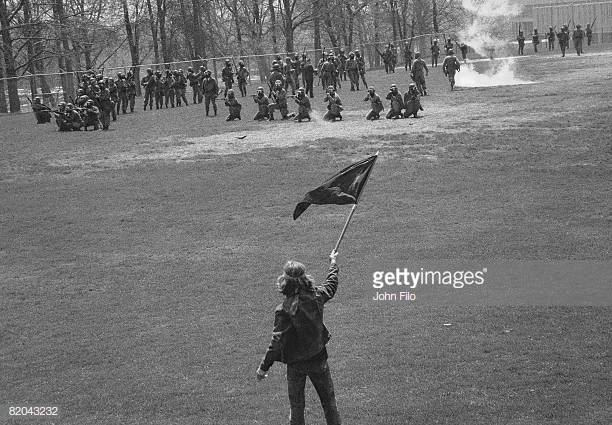
After a relatively calm Sunday, students began gathering in the Commons area Monday morning, May 4. At approximately noon, students rang the freedom bell, signaling the start of the demonstration. They were now not only protesting the Vietnam War, they were increasingly enraged over the presence of the Ohio National Guard on campus. No one, on either side, could have imagined what came next.
For one, the students could not find it conceivable that the rifles the Guardsmen were carrying actually had bullets in them; they assumed the guns were loaded with blanks. Therefore, there was nothing to worry about. The Guard wasn’t about to fire real bullets into unarmed students. That just couldn’t and wouldn’t happen in America, certainly not on a college campus; but it did. After some 61-67 rounds went off over 13 seconds, 4 students lay dead, or dying. Nine other students were hit but would survive; one, however, suffered lifelong paralysis. Americans fired on Americans on American soil. The Vietnam War had officially come home.
Why the Guard began firing is still unclear to this day.
What we do know is that as many as 12 Guardsmen turned in unison, pointed their guns simultaneously and began firing.

“I heard an order, I believe, from Major Jones, stating ‘turn and face the crowd.’ The shooting started shortly after.” Ohio National Guard Sgt. Richard K. Love, statement to Ohio Highway Patrol, 1970.
The commanding officers on the scene all denied giving an order, shifting the blame away from the officers onto the triggermen. Some of the soldiers later said they felt afraid for their lives; yet the four students who were killed were between 80 and 130 yards away from the shooters, as were the majority of the students who were wounded. The demonstration was in fact breaking up when the shooting began. It was nearly 12:30, and many of the students had to get to class.
“I don’t think any order to fire was given. I have no information that would indicate that in any shape or form.” Ron Snyder, Captain, Ohio National Guard.
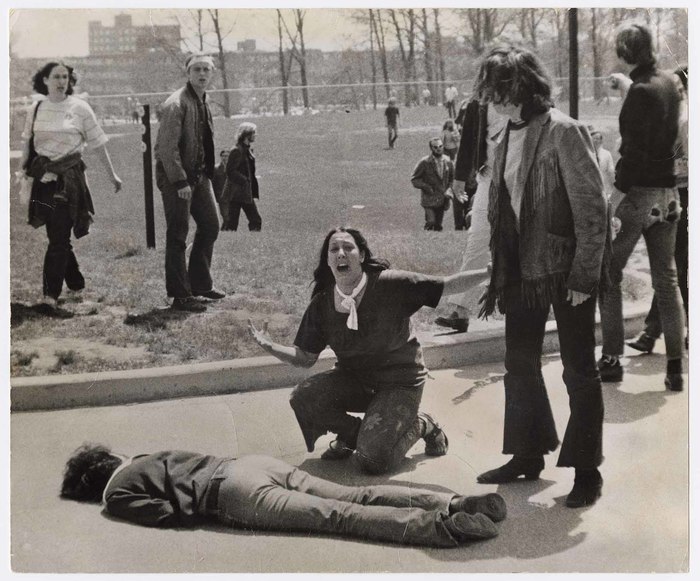
If no order was given, then how would you explain why at least 12 men stopped, turned in unison and fired at students, most of whom were relatively far away in a parking lot? The ‘fearing their lives’ concept doesn’t add up. The students were unarmed and dispersing when the shooting began.
In a press conference the day before, Governor Rhodes, with his fist pounding against a table, called the students “worse than the brownshirt and the Communist element and also the nightriders and the vigilantes. They’re the worst type of people we harbor in America.”
Those “worst type of people” — referenced by Rhodes — were students, some protesting; others simply passing by in curiosity. The four students who died at Kent State are (left to right in the cover photo): Allison Krause, William Schroeder, Sandra Scheuer and Jeffrey Miller. Schroeder and Scheuer were not even participating in the protests; they were heading to their next class when they were struck down in a parking lot.
Krause was described by her mother as “very pretty, and people took to her.” She was also “very headstrong, just like her father, who landed in Normandy during the D-Day invasions. They were two of a kind that way.”

“These students are going to have to find out what law and order is all about. Make sure you have your weapons in ready positions.” Brigadier General Robert Canterbury, Ohio National Guard, Kent State University Commons, May 4, 1970.
The families of the victims had to fight in court for nine years before reaching a meager settlement. No one went to jail. There were never any apologies and/or statements of regret from either Rhodes or Canterbury. According to Elaine Holstein, the mother of deceased student Jeffrey Miller, each family whose child died at Kent State received a tiny settlement after signing off.
“We had to sign, that we would bring no further suits, signing away any rights. At the end of our legal battles, we were pressured by the judge and by our lawyers into accepting a settlement in which the parents of the dead students discovered that their sons’ and daughters’ lives were worth a mere $15,000 each.
“It was never about the money for me. I wanted an admission of culpability, and more than that, I wanted an assurance that no mother would ever again have to bury a child for simply exercising the freedom of speech. But all we got was a watered-down statement that better ways must be found.
“I also discovered what I perhaps should have known already, that so many of my compatriots did not feel as I did. They believed that the students who were killed or wounded got what they deserved and, as I heard far too often, the National Guard ‘should have killed more of them.’”
After President Nixon ordered an investigation, the conclusion that would eventually come was that the “killings were unwarranted, unnecessary and inexcusable.”
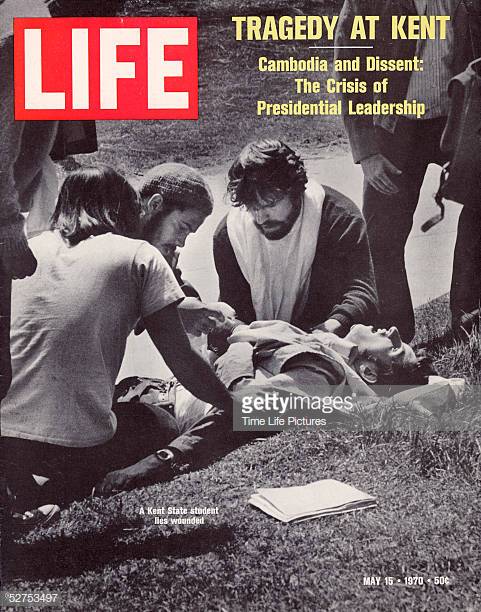
George Schultz, Secretary of Labor in Nixon’s cabinet at the time, and a WWII Marine artillery captain, viewed film of the Kent State shooting. Rather than support the administration’s claims that the guardsmen’s shots were random, Schultz said, “I know a fusillade when I see one, and that was a fusillade.” A fusillade is the simultaneous and continuous firing of a group of firearms on command.
Major Harry Jones, Ohio National Guard at the scene during the shootings, testified in Federal Court in 1975. “My personal opinion as a professional officer is that the firing was not justified under those circumstances…It is my honest opinion it should not have happened.”
“Don’t worry, you did what you felt you had to do.” General Robert Canterbury, Ohio National Guard, statement to shooters minutes after massacre, May 4, 1970.
Soon after the massacre, hundreds of defiant students began reassembling in the Commons area. General Canterbury, despite the fact that students were already dead and/or dying, began readying his Guardsmen for another assault. Thank God it was averted when Kent State Professor Glenn Frank, bullhorn in hand, pleaded with the students to disperse. Thankfully, his plea worked before Canterbury had another opportunity to fire on unarmed college students.
“I don’t care whether you’ve never listened to anyone before in your lives. I am begging you right now. If you don’t disperse right now, they’re going to move in and it can only be a slaughter. Jesus Christ…I don’t want to be a part of this.” Professor Glenn Frank
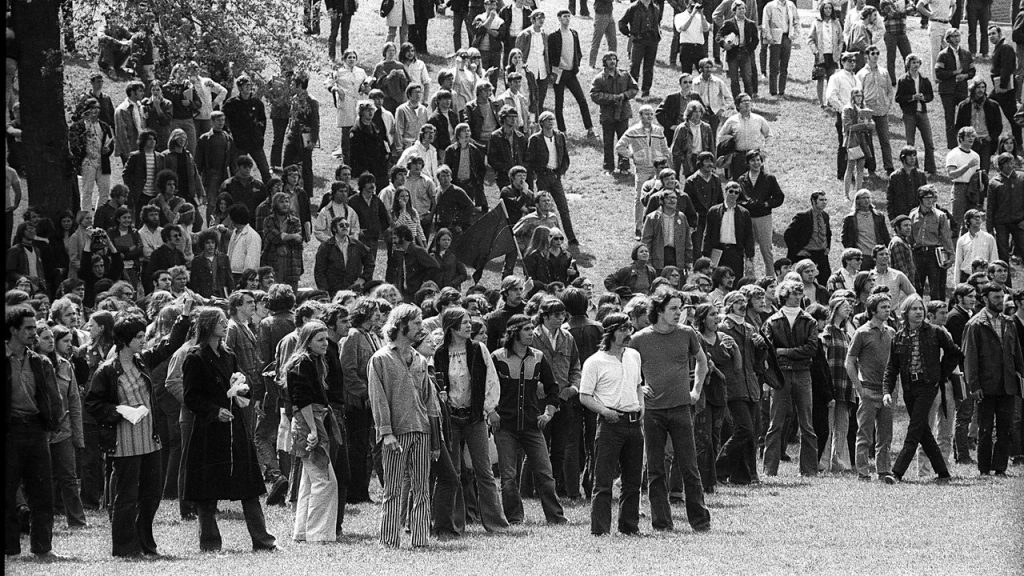
Years later, Ohio Guardsmen issued the following statement.
“We devoutly wish that a means had been found to avoid the May 4th events culminating in the Guard shootings and the irreversible deaths and injuries. We deeply regret those events and are profoundly saddened by the deaths of four students and the wounding of nine others which resulted.”
The Guardsmen considered it to be a declaration of regret, not an apology or an admission of wrongdoing.
In 2018, I traveled to Kent State to tour the University because my daughter was interested in attending. She’s now getting ready to graduate from Kent. I had always wondered how the University dealt with what happened there 52 years ago. It was comforting to learn that the University embraces the tragic events of May 4, 1970.

I was moved by everything I saw and felt. There is a beautiful granite memorial up on the hill next to Taylor Hall, near the epicenter of the horror. The memorial leads to a walking tour that helps further explain how everything unfolded. There is even a Kent State University May 4 Visitors Center and Museum that provides “an accurate and balanced account of the history that happened there.” The museum tells the “story of an academic community that was and remains deeply committed to teaching the lessons of May 4, 1970 and applying them to make a positive difference in the world.” Beverly Warren, President, Kent State University.

I had also wondered if there would be any markers where the four students fell. Indeed, there are. In fact, those hallowed spaces are clearly marked with personal memorials. Students, who still park in the same lot where Scheuer, Krause and Schroeder fell, maneuver in and out of the lot to this day, around the memorials of course. On the walking path where Miller fell, students navigate around his clearly marked memorial. Some stop to reflect.
I was impressed with Kent State’s commitment to never forgetting what happened there, and I’m certainly proud that my daughter will be a graduate. There are even courses available for students who want to learn more about what happened…an important history lesson woven into the fabric of the school’s culture.
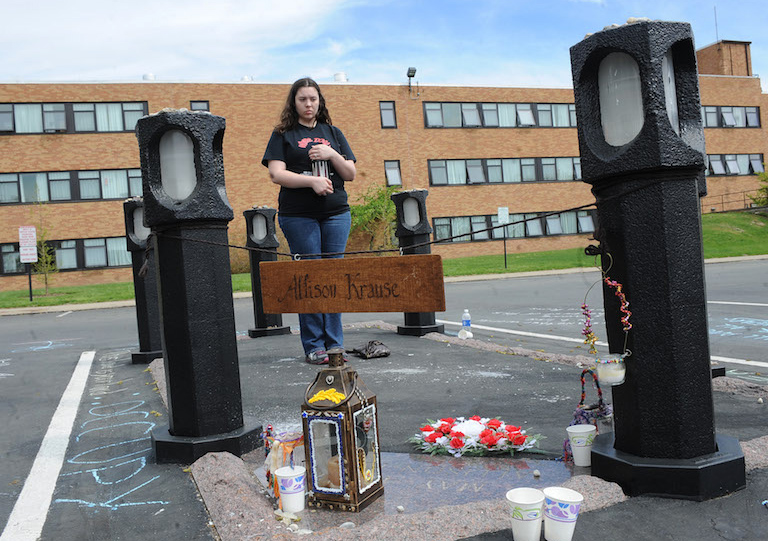
No matter how well we ever understand what happened at Kent State University on May 4, 1970, those four students did not deserve to die; that much I know. So, here’s to those four beautiful students who never got to tell their stories. Who never got to grow up and become all they could be…this one’s for you Allison Krause, Jeffrey Miller, Sandra Scheuer and William Schroeder.
“Dates and facts are not enough to show what happened in the past. It is necessary to delve into the human side of history to come up with the truth. History must be made relevant to the present to make it useful.” Allison Krause
Schroeder was a psychology student, who also earned the Association of the United States Army award for excellence in history. Both Scheuer and Krause were honor students. Miller had recently transferred from Michigan State University and was friends with Krause and Scheuer.
Don Radebaugh
Find the History Mystery Man on Facebook and YouTube.

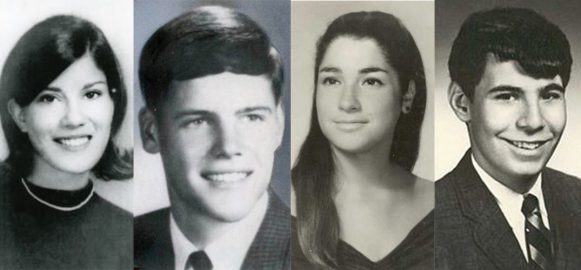
It’s too bad the men who killed these students were never brought to justice! They got away with murder! They should have at least apologized for what they did!
When the shooting started, I remember cheering on the guard. I thought that they could have shot more. I was just out of the ARMY and tired of these hippies. My mind was in another place, as one can easily imagine. Today of course I see the unneccessary horrors of Kent State and places like Saigon.
I am glad you said that. I too had just come back and had the same thoughts about the Hippy’s getting shot. I now feel that it was a terrible tragedy, and that the Government was wrong.